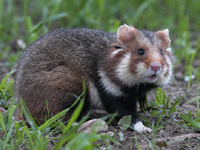

 |

|
 Common Hamster |
Common Hamster(Mammal) |
 Common Hamster Baby |
Common Hamster HabitsThe hamster prefers dry, sandy soil where it can dig its underground burrows and runways easily. It inhabits all types of grassy and
cultivated land. It can also be found on lowland hills up to an altitude of 2,000 feet.
The hamster lives in a burrow year round, digging different burrows according to season. Its burrow can be extensive�the size depends on the age of the animal. In some areas where the soil and vegetation are suitable, many burrows may be crowded into one small area.
In the winter, the hamster withdraws to its burrow and closes up the entrances with soil. It hibernates in the burrow in a grass-lined nest.
Although its body temperature drops from 90� F to 39� F, it is not a true hibernator because it does not survive off its fat, but wakes every 5-7 days to feed from the stored food supply. |
Common Hamster CommunicationHamsters communicate through ultrasonic sounds at a frequency that is undetectable by the human ear. Those sounds that humans can hear include squeaking, hissing and screeching, all of which typically indicate fear, discomfort or pain. Sometimes, when extremely stressed, the squeaking can become very loud and piercing, sounding almost like the hamster is screaming or yelling. |
Common Hamster BreedingCommon hamsters breed throughout late spring and summer. During this time, they produce a number of litters. The males move into the females' burrows while breeding, but are quickly driven out after mating.
After an 18-20 day gestation period, 4-12 blind and naked young are born in a nest chamber within the
burrow.
They weigh only a half ounce at birth, but within a week, even though their eyes are still closed, they will begin to nibble at grass. Their eyes open after 2 weeks, by which time they have grown a thick coat of fur. They are completely weaned at 3 weeks.
The female is extremely protective of her young. If they are threatened, she gathers them into her mouth, either by putting them into her cheek pouches or laying them across the toothless area between the incisors and molars. |
Common Hamster Food & FeedingThe common hamster feeds mainly at night on plant matter including grass, clover, beans, lentils, grains, flowers, seeds, rooted vegetables, and the green parts of plants. It will also eat insects, lizards, frogs, small birds, field mice, and its favoriteearthworms.
If a number of hamsters inhabit the same area, food shortages can force the population to find new feeding grounds. During such a journey, the hamster may swim across large rivers.
Toward the end of fall, the hamster collects food to store for the coming winter. It carries rooted vegetables between its front teeth and fills its cheek pouches full of beans and other seeds with its extremely coordinated front paws. Once it is in the
burrow, it uses its paws to squeeze its cheeks to empty the food into a chamber which it has specially excavated for the purpose. |
Common Hamster Key Facts |
| Size |
| Height: Length: 8-14 inches. Tail: 1-2 inches |
| Weight: 4-32 ounces |
| Breeding |
| Sexual maturity: Females are receptive at 43 days old |
| Mating: Early April to August |
| Gestation: 18-20 days |
| Number of young: 4-12 |
| Lifestyle |
| Habit: Solitary, lives in complex system of burrows |
| Diet: Feeds mainly on grasses, seeds, grain, legume crops, and root vegetables |
| Lifespan: 2 years |
DID YOU KNOW?
|
CAN'T FIND WHAT YOU'RE LOOKING FOR? CLICK HERE!!!